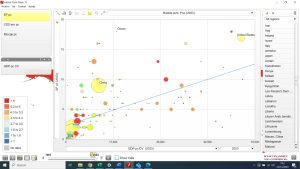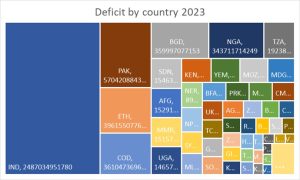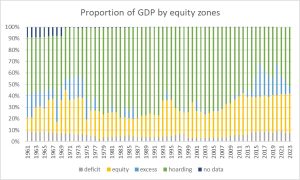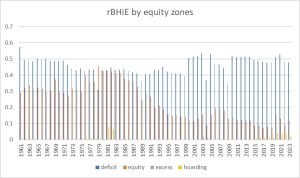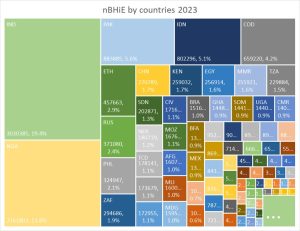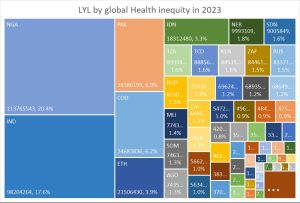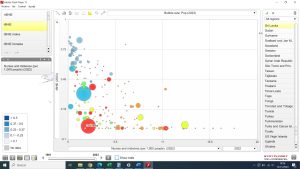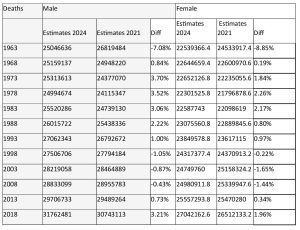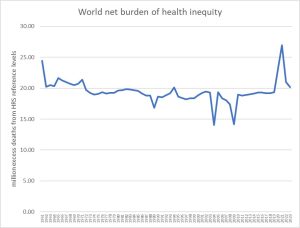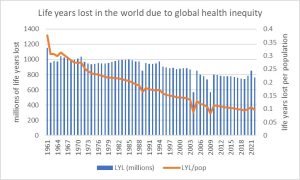IN A NUTSHELL Author's noteMany countries recruit foreign-born and foreign-trained health workers who are given opportunities to immigrate to another country where they find new employment and often also additional training opportunities. However, the emigration of health workers imposes significant costs on poor countries, which lose trained professionals already in short supply. This causes deficiencies in the supply of competent health workers, often further deepening poverty due to a serious lack of medical care providers, thereby negatively affecting social justice. The most recent policy paper jointly authored by WHO and OECD deserves critical attention since it makes in-depth proposals for liberalizing migration agreements of health workers between countries without adequate consultation nor participation of civil society. Hence, the purpose of this article is to discuss the complex issue of cross-border health worker recruitment and migration from a perspective of social justice and sustainable development and to propose solutions to this multi-faceted problem
By Raymond Saner, Ph.D.
Director, Centre for Socio-Eco-Nomic Development-CSEND
Geneva, Switzerland
WHO and Immigrant Health Workers: A Social Justice Perspective
Introduction
This article examines the complexities of international health worker migration through the lens of social justice. The International Labour Organization (ILO) defines social justice as a foundational principle that ensures fair and equitable access to opportunities, rights, and resources within society. It underpins the ILO’s mandate of promoting decent work, equity, and social inclusion.
The notion of Social Justice goes back to the founding of the ILO in 1919, is aligned with the social justice objectives of the broader framework of the Universal Declaration of Human Rights in 1948, particularly regarding economic and social rights (Articles 23 and 25).
Social Justice was further developed by the ILO in 2003 calling for integration of social justice with employment policies addressing the need for equality and inclusion. In 2008 Social Justice was put forth by the ILO member countries in the international context calling for a Fair Globalization (2008) and the ILO Centenary Declaration for the Future of Work (2019) reinforces the importance of social justice in adapting to transformations in the world of work, including technological and environmental changes.
The newly elected ILO Director-General Gilbert F. Houngbo emphasized in his speech on 18th December 2023, that social justice involves addressing inequalities and discrimination, ensuring every individual has equal opportunities, and providing a minimum level of social protection. Social justice therefore encompasses access to education, food security, adequate water and sanitation, safe and healthy working conditions, and the freedom to express one’s views.
Although the World Health Organization (WHO) does not provide a formal, standalone definition of social justice, the concept is integral to its work and mission. The WHO emphasizes social justice as a fundamental principle in achieving health equity and reducing health disparities.
The WHO defines health equity as the absence of avoidable or remediable differences among populations or groups. Social justice is seen as a driving force for reducing these inequalities. The WHO also recognizes that social justice requires addressing the social determinants of health, such as income, education, employment, and access to healthcare. Social justice also underpins the WHO’s advocacy for universal health coverage, ensuring that everyone can access healthcare without financial hardship.
Like the ILO, the WHO also aligns its principles with the Universal Declaration of Human Rights (Article 25), advocating for health as a fundamental human right and a social justice issue. WHO Constitution (1948) describes social justice as an ethical imperative in public health, focusing on reducing health inequities and ensuring fair distribution of resources.
Social Justice: International Health Worker and Labour Markets
In some countries, foreign-born and often also foreign-trained health workers represent a high percentage of the total health workforce. For example, the United Kingdom has approximately 28% of doctors and 15% of nurses who are foreign-trained, Canada counts 24% of doctors and 19% of nurses who are internationally educated, and in the USA in 2018, there were 28% foreign-born and foreign-trained doctors and 16% nurses. On the other hand, some European countries show a lower share of foreign health workers such as France 11.6% doctors, 2.9% nurses in 2019 and Germany 13.8% doctors, 9.6% nurses in 2021.
Statistics about movements of health force workers are not always easily and transparently available and often vary substantially between rural versus urban population centers. For instance, as of 2021, 38.4% of doctors and 25.6% of nurses in Switzerland have trained abroad and these figures are considerably higher for the major Swiss cities like Zurich, Basel and Geneva.
In the Gulf Cooperation Council (GCC) countries—Bahrain, Kuwait, Oman, Qatar, Saudi Arabia, and the United Arab Emirates, a significant portion of the healthcare workforce comprises expatriates in the mid-2020s. Approximately 75% of physicians and 79% of nurses working in these nations are foreign-trained professionals. These figures underscore the substantial reliance on foreign-trained healthcare professionals across the GCC countries. Efforts are ongoing to develop local talent and reduce dependency on expatriate health workers in the healthcare sector but the results of such health sector policies have not been effective so far.
Imbalances in the supply and demand of doctors and nurses generate job opportunities for health workers in developing countries and in some developed countries alike. While such pull effects can offer possibilities for well-paid jobs and career improvements, the other side of the resulting labor force migration is the loss of trained health workers in the sending countries. While the main emigration flow of health workers occurs from developing countries, some developed countries like Spain and Eastern Europe have also been losing trained health workers to Central European countries due to lower pay and difficult working conditions.
With this said, developing and low-income developing countries are experiencing a much more serious loss of health workers, which further amplifies already existing conditions of scarcity of health workforce supply and the unintended consequences. For instance, Malawi faced significant challenges due to the emigration of its healthcare workers, a phenomenon often referred to as “brain drain.” This migration has led to critical shortages in the country’s health sector, impacting the delivery of essential medical services. In 2002, approximately 59% of the 493 doctors born and trained in Malawi were working abroad and in the same period, 16% of the 2,248 Malawian-trained nurses had emigrated. As of 2018/2019, Malawi had approximately 10.42 core health workers per 10,000 population, about 45% of the World Health Organization’s recommended target of 22 health workers per 10,000 population.
Recruitment of health professionals from advanced countries offers, most of the time, advantageous job opportunities for those who emigrate while the sending country suffers brain-drain; in other words, a loss of health care providers who benefitted from education paid by sender countries taxpayers who are left with a reduced health workforce and related reduced health care services all of this negatively affecting a sense of social justice.
Social Justice: Drivers of Health Work Force Gaps
Recruiting foreign health workers can be the result of deliberate health sector manpower planning preferences for recruiting foreign labour rather than producing health worker supply domestically. Such preference for a larger percentage of foreign health workers could be for instance due to political pressures by dominant health service providers like doctors or specialized nurses who do not want to expand existing supply of professional health workers despite of the evident labour shortage. Rationale is such that greater supply of legally secure specialized health workers could dilute or reduce their bargaining power, consequently impact their salary and possibly working conditions.
A contrarian policy could be the preference of a government to allow foreign health workers entering the local health care market as a strategy to reduce the bargaining power of the local health work force. Recruiting foreign health workers could reduce health care costs if foreign health workers are paid lower salaries than local health workers and are faced with job insecurity and loss of work permits in case of labour conflicts and strikes by the national health workers who have secure labour rights and social protection.
Another situation leading to recruitment of foreign health workers could be due to gaps in the national health care labour markets due to an absence of professional national health policy planning resulting in an important fluctuation of basic health education of doctors and nurses. Such lack of rigorous planning of health care education can be due to bad budgeting of basic medical education, budget cuts or budget re-allocation to other sectors. The consequence being that it might be cheaper to import health workers already trained in advanced health methods rather than systematically invest in health education at home.
Social Justice: Discriminatory Labor Practices
Different forms of institutional injustice exist against foreign health workers in the receiving countries. They are:
Visa and Work Permits: foreign health workers may have to navigate restrictive visa and work permit requirements that tie them to specific employers, limiting their job mobility. Some countries use sponsorship systems (e.g., Gulf Cooperation Council states), which can create dependency on employers and risk exploitation.
Contractual Differences: foreign workers may be hired on temporary contracts, unlike native workers who might have access to permanent positions. In some European countries, foreign-trained nurses are initially placed on probationary terms or lower pay grades.
Salary and Benefits: foreign health workers often receive lower salaries compared to their host country counterparts, even when performing the same roles. In the United Kingdom, some foreign nurses on international recruitment schemes earn less than local staff due to different contract terms.
Limited Benefits: foreign workers may lack access to the same benefits as natives, such as pensions, health insurance, or maternity leave. In some cases, benefits depend on citizenship or residency status.
Work Assignments: foreign health workers are often assigned to less desirable or more physically demanding roles and tasks. Foreign nurses may disproportionately work night shifts, at rural clinics, or understaffed specialties.
High-Stress Environments: due to shortages in underserved areas, foreign workers may be placed in high-pressure environments with inadequate resources.
Discrimination and Workplace Integration: foreign health workers often face implicit or explicit bias, including stereotyping, no recognition, unequal opportunities for promotions, or exclusion from decision-making. Studies in Australia and the UK have reported that migrant nurses frequently experience workplace bullying or isolation.
Slower Career Progression: foreign workers often face slower promotions due to implicit bias or systemic barriers in recognizing their qualifications and achievements.
Regulatory and Ethical Challenges: foreign workers may lack the same labor protections as native workers, making it harder to contest unfair treatment or negotiate better conditions.
In summary, foreign health workers often face unequal working rights, creating systemic barriers to fairness and integration. Addressing these disparities requires changes in policy, enforcement of equal rights, and cultural shifts to value the contributions of migrant health workers.
Social Justice: Labour Rights of Foreign Health Workers
In many countries, foreign workers have the same right to strike as native workers, provided they are legally employed. However, participation in strikes may still be subject to restrictions based on their employment contract or visa conditions. A quick overview of the situations in selected countries which are the major destinations of the migration flows of the health workers:
Countries without Restrictions on Foreign Workers Striking
United Kingdom: foreign health workers employed in the NHS or private sector can participate in lawful strikes organized by unions, such as the British Medical Association (BMA) or the Royal College of Nursing (RCN). However, their immigration status (e.g., visa conditions) risks to be compromised by participating in industrial action.
United States: foreign health workers on visas like the H-1B or J-1 may legally join strikes if they are members of a union organizing the action. However, employers must notify immigration authorities, which can create risks for visa holders.
Canada: foreign health workers who are union members can participate in strikes, provided the action complies with labor laws. Temporary foreign workers, however, may face challenges due to contractual obligations or work permits tied to specific employers.
Countries with Restrictions on Foreign Workers Striking
In some countries, foreign workers may face legal or de facto restrictions on participating in strikes. These restrictions can arise from labor laws, visa conditions, or government policies. Examples are:
Gulf Cooperation Council (GCC) Countries (e.g., Saudi Arabia, UAE, and Qatar): strikes are generally illegal for all workers, and participation can lead to deportation or termination, especially for migrant health workers tied to the kafala system, or sponsorship system which gives private citizens and companies in most Arab Gulf countries almost total control over migrant workers’ employment and immigration status[1].
Germany: while strikes are generally legal, foreign workers must be union members to participate. Migrant workers on temporary contracts may hesitate to join due to fears of job loss or visa complications.
France: foreign health workers can strike, but those on probationary or temporary contracts might face repercussions, such as non-renewal of their contracts.
Legal and Practical Risks for Foreign Workers When Striking
Employers may terminate foreign workers’ contracts for participating in strikes, particularly in non-unionized workplaces or where strikes are seen as disruptive.
In some countries, striking may be considered a breach of visa conditions, leading to visa cancellation or deportation and in other countries, foreign workers dependent on a single employer for their visa may face retaliation if they participate in strikes.
Foreign workers who are members of unions are often better protected during strikes, as unions provide legal and financial support. Foreign workers may fear backlash or being perceived as “ungrateful” for participating in strikes, even when they face the same workplace issues as native workers.
Social Justice: Labour Rights for Local and Immigrant Health Workers facing Uber Type Employment Conditions
A recent 2024 joint publication by WHO and OECD titled “Bilateral agreements on health worker migration and mobility” deserves close attention in light of this publication’s focus on Social Justice. As stated in the executive summary, the third objective of the publication is to “articulate policy considerations to inform the design, implementation, monitoring and evaluation of migration and mobility agreements, consistent with the objectives and principles of the WHO Global Code of Practice on the International Recruitment of Health Personnel (“the Code”) and other relevant international instruments”. It further clarifies that this publication is a guidance tool “for improving the capacity of state actors involved in the development, negotiation, implementation, monitoring and evaluation of agreements related to international health worker migration and mobility, in alignment with the provisions of the Code”.
The readers targeted by the authors of this WHO-OECD joint publication are governments, state actors, who have decision power in the multilateral organizations like the WHO, WTO, ILO and UNESCO; in bilateral agreements (FTAs) negotiations and plurilateral (RTAs) negotiations; but specifically in the context of bilateral agreements related to International Health Worker, i.e., state-to-state agreements of sending and receiving emigrant and immigrant health workers to destination and countries of origin, emigrant and immigrant health workers.
The only other actors in determining the conditions of the mobility of health workforce are multinational health chain companies who increasingly take part in the state-to-state health workforce negotiations and agreements (see below). Yet, the workers’ rights representatives are not at the table. No labour unions, no civil society organizations are part of these agreements as active and equal partners.
The document is very well researched and solutions are smartly augmented and in-depth referenced. Regrettably, the authors only speak of rights and obligations of states but leave out the rights of health workers and to which authorities that they can call for assistance in case of labour disputes between employers (e.g. state hospitals of host countries) and employees (migrant health workers).
While the paper draws on international agreements like WTO, WHO, UNESCO, ILO and an international non-binding guidance document called “Global Compact”, the WHO-OECD paper makes only soft reference to the ILO conventions. For instance, footnotes 2, 3, 43, 44, 46 and 47 refer to ILO documents, yet none of these references spell out in clear language what the basic ILO conventions mean and the state obligations in protecting their labour rights.
For instance, the ILO’s “1998 Declaration on Fundamental Principles and Rights at Work* outlines the core labour standards that all member states are expected to respect and promote. These principles include:
- Freedom of Association and the Right to Collective Bargaining: This principle emphasizes the importance of workers’ rights to form and join trade unions and to engage in collective bargaining to improve their working conditions.
- Elimination of All Forms of Forced or Compulsory Labour:
This principle seeks to eradicate forced labour in all its forms, ensuring that all work is freely chosen and that workers are not coerced into employment. - Effective Abolition of Child Labour:
This principle aims to eliminate child labour, particularly in its worst forms, and to ensure that children have access to education and the opportunity to develop in a healthy environment. - Elimination of Discrimination in Respect of Employment and Occupation:
This principle calls for equal opportunities and treatment for all workers, regardless of their race, gender, religion, or other personal characteristics.
These core principles are at the heart of the ILO labour conventions and valid for all labour related conditions be they domestic or international. Labor conditions for immigrant health workers are generally governed by national labor laws and international labor standards, such as those set by the International Labour Organization (ILO). These regulations aim to ensure fair treatment, safe working environments, and equitable compensation for all workers, regardless of their origin. Even so, it remains essential that all workers are equipped with basic understanding of these fundamental labour rights in order to exercise their rights as right holders.
The WHO-OECD paper presents at length and in detail the General Agreement on Trade in Services (GATS), established by the World Trade Organization (WTO) which sets the framework for international trade in services, including health services. However, GATS primarily focuses on facilitating trade and does not directly address labor conditions or workers’ rights, including those of immigrant health workers.
In practice, the labor conditions of immigrant health workers can vary significantly between countries and institutions. Factors influencing these conditions include local labor laws, enforcement mechanisms, and the specific policies of healthcare institutions. For instance, in the United States, immigrant health care workers often occupy essential roles, with women comprising 75% of the 2.8 million immigrant health care workers as of 2021.
Despite the critical contributions of immigrant health workers, challenges such as underemployment, credential recognition, and workplace discrimination persist. Addressing these issues requires concerted efforts at national and international levels to ensure that labor conditions meet established standards and that immigrant health workers receive fair and equitable treatment.
Social Justice: Risks due to Uber-type Health Companies
The trend is increasing of foreign retirees who opt to live or seek treatment in other countries and at the same time, privately owned international health companies import health workers from their home countries to the foreign destination health spas to attend to retirees or health seeking adults from developed countries. This trend is growing due to globalization, aging populations, and the rising demand for culturally competent care whereas the international brand offers assurance of quality of health services to their international clientele.
Retirees from developed countries move abroad for treatment or retirement to save health costs and also more personalized care. Healthcare and living costs in some countries are significantly lower than in their home countries. Many Western retirees move to countries like Thailand, Malaysia, or Mexico, where high-quality healthcare is available at lower and thus affordable costs.
Retirees might also seek access to specialized services. Some retirees seek out countries with well-regarded medical facilities or expertise in certain areas, such as joint replacement or rehabilitation and a growing number of retirees are drawn to countries with warm climates, relaxed lifestyles, and expat-friendly communities. Other important reasons can also be long waiting times or shortages of healthcare workers in their home country that push retirees to seek care abroad.
Some international healthcare companies recruit foreign health workers to attend to expatriate retirees, especially when specific cultural, linguistic, or medical expertise is needed for the following reasons for importing foreign health workers:
Retirees may prefer caregivers who speak their mother tongue and understand their cultural norms. For instance, Japanese retirees in Malaysia may feel more comfortable with Japanese-speaking nurses who understand their dietary and cultural preferences. Malaysia has since become a hub for Japanese retirees due to affordable healthcare and expat-friendly policies. Privately owned facilities, such as Nichi-In Centre, cater specifically to Japanese retirees and often employ Japanese-speaking nurses and caregivers.
Foreign health workers may bring expertise in medical practices or caregiving approaches that align with the expectations of retirees from their home country. Companies offering culturally specific care can better attract and retain clients from particular countries. German retirees living in Thailand often seek care at private hospitals that employ German-speaking doctors and nurses. Some facilities in Mexico and Costa Rica recruit bilingual staff (English-Spanish) to accommodate American and Canadian retirees. U.S.-based healthcare companies sometimes set up satellite operations in these regions.
Some destinations may lack sufficient healthcare workers with the skills or qualifications to meet international professional diagnostic and treatment standards. In countries like the UAE and Qatar, private hospitals and clinics employ Indian nurses and doctors who cater to local population in general and to a significant Indian expatriate population, including retirees who rely on home based medical travel agencies.
For less intensive needs, retirees can access healthcare professionals from their home country through telemedicine platforms while staying in less expensive and pleasant treatment facilities abroad and some companies bring foreign health workers for short-term contracts to provide specialized care, reducing costs and regulatory hurdles. The challenges and rights of health workers in these Uber-Type Health Companies consist of the following dimensions:
Most Uber-like platforms classify workers as independent contractors rather than employees. This limits their access to minimum wage protections, social benefits (e.g., healthcare, sick leave, pensions) and job security and protections from unfair termination due to their non-employee status. Platforms like Zocdoc (https://www.zocdoc.com/) or Heal (https://www.healitalia.eu/en/) may classify doctors or nurses as contractors, leaving them responsible for their own benefits and insurance. A doctor working for an on-demand telemedicine platform may not receive disability coverage if injured. As contractors often lack access to employer-sponsored health insurance or contributions to social security systems, leaving them vulnerable in case of illness or injury.
Gig health workers usually do not qualify for unemployment insurance either if they lose their contract. Health worker contractors often have no guaranteed minimum income, as their earnings depend on the number of patients or appointments completed. For instance, nurses working for a platform may experience seasonal fluctuations in demand, impacting their income. Some platforms use opaque algorithms to determine worker pay, leading to complaints about unfair or inconsistent compensation.
Health workers must often meet local licensing requirements, even if the platform facilitates cross-border work. Failure to comply can result in legal or financial penalties and contractors are often required to carry their own malpractice insurance, unlike employees, whose employers typically provide such insurance coverage.
In regard to union rights, in many countries, contractors lack the legal right to unionize or engage in collective bargaining, leaving them with less power to negotiate pay or working conditions. For instance, efforts by gig workers to unionize in the U.S. have faced significant legal hurdles but in some countries, such as Spain, laws have been passed that grant gig workers the same rights as employees, including union protections.
There are also ethical and regulatory concerns. Health workers may feel pressured to prioritize speed over quality due to pay-per-task models. Doctors on gig platforms might be incentivized to see as many patients as possible, potentially compromising care quality and platforms may require workers to use proprietary apps, raising concerns about the privacy of both patient and worker data.
Counter Measures
Most of the migrant health agreements between exporting and importing health workers do not have protective provisions to prevent abusive work conditions as described above. The WHO-OECD paper does not provide suggestions how international health workers could protect themselves from exploitative work conditions of Uber-type private health operators.
Health workers in Uber-like models often face precarious conditions with limited rights compared to traditional employees. Protecting health workers in Uber-Type work models could consist of requiring platforms to classify health workers as employees or offer a hybrid status with certain rights, such as access to benefits and minimum pay guarantees. Another measure could be to develop systems where gig workers can access benefits (e.g., pensions, health insurance) tied to their work across multiple platforms.
Wherever the local laws permit, it would be good to enable gig health workers to unionize and negotiate collectively, regardless of contractor status and to mandate transparency in pay calculations and patient assignment algorithms. Another protective measure could be to establish clear frameworks for licensing and professional liability to protect both workers and patients.
Governments, platforms, and industry regulators need to address these disparities to ensure fair working conditions, adequate protections, and the delivery of quality healthcare. Ultimately, it will be in the interest of the patients ton receive care through competent, motivated, secure and caring health workers regardless of origin.
Social Justice: How to Include Labour Rights in the WTO GATS Health Agreement
In light of the in-depth reference made by the joint WHO-OECD 2024 publication mentioned above, the following section goes into a more detailed analysis of the positions put forward by the authors of the WHO-OECD 2024 joint publication from a perspective of social justice and equity. Here are the main arguments:
The General Agreement on Trade in Services (GATS) of WTO covers 12 service sectors, which are further divided into sub-sectors. These service sectors are defined in the WTO Services Sectoral Classification List (W/120 document) and align with the United Nations Central Product Classification (CPC) system.
According to the WTO rules, The General Agreement on Trade in Services (GATS) defines four modes of supplying services internationally:
Mode 1: Cross-Border Supply – Services are provided from the territory of one member into the territory of another, without the supplier or consumer moving. An example is a doctor in one country providing telemedicine consultations to patients in another country.
Mode 2: Consumption Abroad – The consumer travels to the supplier’s country to consume the service. For instance, a patient traveling abroad to receive medical treatment.
Mode 3: Commercial Presence – A service supplier establishes a physical presence, such as a hospital or clinic, in another member’s territory to provide services.
Mode 4: Presence of Natural Persons – Individuals travel to another member’s territory to supply services temporarily, like a doctor working abroad on a short-term assignment.
These modes categorize various ways services can be traded internationally under the GATS framework. The 12 services sectors that are tradeable consist of the following:
- Business Services: Includes professional services (e.g., legal, accounting, architectural), computer and related services, and consulting.
- Communication Services: Includes postal, courier, telecommunication, and audiovisual services.
- Construction and Related Engineering Services: Covers building construction, civil engineering, and specialized trade activities like installation and assembly.
- Distribution Services: Encompasses wholesale trade, retail trade, franchising, and commission agency services.
- Educational Services: Includes primary, secondary, higher education, adult education, and other specialized training.
- Environmental Services: Covers services related to sewage, refuse disposal, sanitation, and environmental cleanup.
- Financial Services: Includes insurance, banking, asset management, and other financial intermediation services.
- Health-Related and Social Services: Includes hospital services, health practitioner services, and social work services.
- Tourism and Travel-Related Services: Encompasses hotel, restaurant, travel agency, and tour operator services.
- Recreational, Cultural, and Sporting Services: Includes services related to entertainment, sports, news agencies, and libraries.
- Transport Services: Covers air, maritime, rail, road transport, and auxiliary transport services like cargo handling.
- Other Services Not Elsewhere Classified: A catch-all category for services not covered in the other sectors, such as domestic help.
GATS Mode 3 and Mode 4 in Health Services:
- Mode 3: Commercial presence—where a foreign company sets up operations (e.g., hospitals, clinics) in the host country.
- Mode 4: Movement of natural persons—allowing temporary cross-border movement of health professionals or workers to provide services.
While GATS primarily aims to liberalize trade in services, it does not directly impose labor standards or ensure worker protections. This creates regulatory gaps that foreign entities might exploit.
Potential Exploitation of Emigrant Health Workers Under GATS:
Platform Models in Health Care: A foreign private health chain could establish a commercial presence under Mode 3 to operate hospitals or clinics. Using platform-based health services, the company could employ remote or “gig-based” health workers (telemedicine, remote diagnostic services) from countries with lower labor costs. These health workers could be categorized as independent contractors or entrepreneurs, excluding them from protections under local labor laws.
By treating workers as self-employed entrepreneurs, the platform avoids obligations such as minimum wages, working hours, health insurance, or other benefits. Workers providing cross-border services may fall into legal gray zones where neither the host country’s nor the originating country’s labor protections fully apply.
A host country might struggle to enforce labor protections for workers who do not physically reside within its borders and domestic healthcare workers might face unfair competition from lower-cost, less-regulated foreign labor.
While GATS has general exceptions (e.g., Article XIV for public policy objectives, including protecting human health), these exceptions are not explicitly designed to address labor conditions. This necessitates supplementary measures. Countries can restrict commercial presence to entities that adhere to specific labor protections (e.g., requiring that all health workers, including gig workers, be treated as employees under local labor laws).
Host country governments can impose local content requirements to prioritize employment of domestic health workers. Such agreements can include explicit provisions to regulate labor conditions, ensuring that cross-border workers are afforded minimum protections.
International Advocacy can be important in promoting public awareness and joint actions. Entities like the International Labour Organization (ILO) and World Health Organization (WHO) could advocate for global standards ensuring fair treatment of health workers under trade agreements.
Risks and Ethical Considerations need to be taken into consideration when allowing international mobility.
The platform-based health model under GATS Modes 3 and 4 could exacerbate inequality. Host countries could face regulatory gaps and risks of downward pressure on labor standard and sending countries could lose skilled health workers to foreign entities while receiving limited economic benefits.
Addressing these issues requires coordinated supraterritorial actions to close legal loopholes, enforce labor standards, and adapt trade agreements to protect workers in the increasingly globalized and digitized health sector.
Reviewing GATS in the Context of Health Services
GATS Mode 1: Cross-Border Supply:
Services are delivered across national borders without the service provider or the consumer physically traveling to the place where the client resides. In healthcare, this includes telemedicine, online consultations, remote diagnostics, and digital health platforms.
The healthcare workers providing these services may remain in the provider’s home country, operating under its legal framework, while delivering services to patients in the host country. The host country’s labor laws typically do not apply because the workers and the service provider are not physically present within the host country. Workers remain subject to the labor laws (or lack thereof) of the provider’s home country, even if they are serving patients in the host country.
Many telemedicine platforms classify health professionals as independent contractors rather than employees. This model often avoids obligations such as minimum wages, health benefits, or social protections and bypasses labor protections in both the host and provider countries.
Health workers in countries with weak labor laws may face exploitative conditions, such as long hours, low pay, or lack of job security, even when delivering services to countries with higher labor standards since Host countries have no jurisdiction over the employment relationship because the health workers are employed (or contracted) by a foreign entity who delivers health services remotely, often digitally.
Foreign Service providers may not be subject to local licensing or operational requirements in the host country, allowing them to bypass local labor and professional standards. Even if a host country attempts to impose conditions (e.g., requiring foreign platforms to comply with local labor laws), enforcement is difficult without bilateral or international agreements.
To address these issues, host countries and international bodies could take steps similar to those suggested for Mode 4 but tailored to Mode 1. Host countries could require foreign health service providers to register locally if they deliver services to residents. As part of the registration process, private health service platforms could be required to demonstrate compliance with minimum labor standards and report employment practices and worker classifications.
Host countries could also pass consumer protection laws which can indirectly impose requirements on service providers, such as transparency about the qualifications, working conditions, and location of health professionals. The country importing health services from abroad could also levy taxes or fees on foreign platforms operating within their jurisdiction and link compliance with labor standards to the ability to operate.
New trade or labor agreements could address the challenges of cross-border services by establishing minimum labor standards for health workers in Mode 1 and by creating mechanisms for enforcement and dispute resolution. In addition, host countries could also encourage international foreign health providers to adopt corporate social responsibility (CSR) practices and help ensure fair treatment of workers, even in unregulated environments.
In closing, the following ethical considerations need to be taken into account in response to the joint publication:
Unmitigated Mode 1 can lead to a “race to the bottom” where health workers in countries with weak labor protections are exploited for the benefit of wealthier host countries. Workers delivering services in Mode 1 may not receive fair compensation or benefits, affecting the sustainability of the global health workforce. Overall, there is a growing need for global labor standards, possibly under the aegis of the International Labour Organization (ILO) or World Health Organization (WHO), to address the unique challenges posed by digital and cross-border health services and an urgent call to improve the functioning of the ILO MNED agreement.
Mode 1 presents similar (and in some cases even more pronounced) challenges as Mode 2 and Mode 4 regarding the enforcement of labor laws in the host country. The absence of physical presence in the host country allows Foreign Service providers to operate outside the reach of local labor standards, leading to significant gaps in worker protections. Addressing this requires both national regulatory innovation and international cooperation to ensure fair labor practices in the globalized health sector.
Urgent Actions: Strengthening the Multilateral Health System’ Rules, Norms and Legal Requirements in Regard to the International Health Work Force
The WHO secretariat has made important efforts to convince the member countries to improve the practice of international health service provisions, address the migration of international health workers, ensure their safety at work, guarantee decent work conditions and find solutions to the brain-drain impact on countries of origin of emigrant health workers.
The key document regarding international health worker migration is the WHO Global Code of Practice on the International Recruitment of Health Personnel adopted in 2010 by the World Health Assembly (WHA Resolution 63.16). It is a voluntary framework that guides the ethical international recruitment of health workers. It aims to address global health workforce imbalances and mitigate the negative impacts of migration on health systems, particularly in low- and middle-income countries.
The Code is global in scope and is intended as a guide for Member States, working together with stakeholders such as health personnel, recruiters, employers, health-professional organizations, relevant sub-regional, regional and global organizations, whether public or private sector, including nongovernmental, and all persons concerned with the international recruitment of health personnel.
Under the leadership of the WHO secretariat, WHO member countries signed three important documents which complement the WHO Global Code of Practice on the International Recruitment of Health Personnel. They address the systemic factors that drive international health workforce migration. They collectively promote sustainable, self-reliant health systems and emphasize that global health workforce mobility occurs ethically and equitably. By aligning their principles with the Code, they aim to achieve Universal Health Coverage (UHC) and improve global health outcomes without compromising the health systems of source countries.
These three documents aligned with the WHO Global Code of Practice on the International Recruitment of Health Personnel are:
- Global Strategy on Human Resources for Health: Workforce 2030. This strategy provides a roadmap to build sustainable and equitable health workforces globally. It aligns with the Code by emphasizing ethical recruitment, data transparency, and the self-reliance of national health systems.
- Report by the High-Level Commission on Health Employment and Economic Growth. This commission focuses on the economic drivers of health workforce development and their alignment with sustainable development goals. It complements the Code by addressing the push and pull factors that influence health worker migration, including better economic opportunities in destination countries.
- Workload Indicators of Staffing Needs (WISN). This tool helps countries identify staffing needs and optimize workforce deployment. By addressing local gaps in health worker distribution, WISN reduces dependency on international recruitment and supports the Code’s aim of equitable workforce allocation.
These documents collectively promote the ethical and sustainable management of health workforce mobility, ensuring that global health workforce migration aligns with the principles of fairness and equity outlined in the WHO Global Code of Practice.
Several reporting instruments are included in the Code to monitor and support its implementation. In 2024, three key instruments were developed for this purpose:
- National Reporting Instrument (NRI) 2024. It enables WHO Member States to self-assess and report on health personnel migration and mobility, aligning with the Code’s objectives.
- Independent Stakeholders Reporting Instrument 2024 allows non-state actors, including health personnel, recruiters, employers, and professional organizations, to report on international health personnel migration and mobility.
- Private Recruitment Agencies Reporting Instrument 2024 is designed for private recruitment agencies to report on their activities related to the international recruitment of health personnel, ensuring alignment with the Code’s ethical standards.
Stakeholders of the above mentioned three reporting instruments were asked to submit their reports by 31st July 2024 for the Recruitment Agencies and Independent Stakeholders; and by 31st August 2024 for the Governments. Since these important and useful reporting instruments are not mandatory, the participation and timely submission varied.
More importantly, the following weaknesses need to be improved, namely:
National Reporting Instrument (NRI). Data submissions are inconsistent. Many countries face challenges in collecting and reporting reliable, comprehensive data due to limited resources or fragmented health workforce information systems. Some Member States may not prioritize reporting or lack political will, leading to gaps in global data.
Reporting processes may also be cumbersome for countries with limited capacity or understaffed health ministries, reducing the frequency and quality of submissions and lack of standardization of interpreting the Code across countries can result in inconsistent reporting.
Independent Stakeholders Reporting Instrument. Non-state actors, including professional organizations and recruiters, may not be fully aware of the instrument or its importance, leading to low participation rates. Without enforcement mechanisms, some stakeholders may provide incomplete, biased, or unreliable data, undermining the instrument’s utility. Smaller organizations or independent stakeholders may also lack the resources to participate meaningfully in the reporting process.
Private Recruitment Agencies Reporting Instrument. Recruitment agencies may be hesitant to disclose practices or data, especially if they are engaging in unethical or borderline practices. The instrument also lacks enforcement mechanisms to ensure compliance with ethical recruitment standards or to penalize non-compliance. Many recruitment agencies, particularly smaller or informal ones, are not included in the reporting process, leading to an incomplete picture of recruitment practices.
General Weaknesses across All Instruments is their voluntary Nature. The instruments align with the voluntary nature of the WHO Code, which means no legal obligation exists to enforce compliance or reporting. Data collected from these instruments is not always effectively integrated with broader global health workforce databases, reducing its impact on policy-making and importantly there are no mechanisms to follow up on or validate the data submitted, leading to potential inaccuracies or omissions.
While the instruments emphasize monitoring and reporting, they do not directly address actionable solutions or mechanisms to tackle systemic issues.
The weaknesses described above could be improved through capacity-building for data collection and reporting in low-resource settings such as creating stakeholder awareness and engagement through training and advocacy. In addition, it could be very useful to introduce accountability measures and incentives for private recruitment agencies and independent stakeholders to participate. It is also foreseeable to include citizen health data as health services tend to be a popular discussion point in many of the social media conversations and exchanges.
Close cooperation with global health workforce platforms like the WHO’s Global Health Workforce Network could contribute to enhance data integration and policy relevance and inclusion of civil society Organizations active in the field of international health work force migration should be included to provide a non-state and non-private sector perspective. A coalition of mostly CSO organization for instance met on 30th May of this year. The coalition organized a side event during the WHO GA titled “Towards a WHO Global Code of Practice that promotes the rights of health and care workers”.
Achieving Social Justice: Make Emerging Agreements Binding Covering Good Practice of International Workforce Migration
Besides strengthening the power of existing WHO instruments as discussed above, additional actions can and should be taken:
- Creating a binding international legal instrument to address health worker migration and mitigate brain drain requires a well-structured, collaborative approach under the auspices of the World Health Organization (WHO) or the United Nations (UN). Below is a step-by-step proposal.
Key Provisions of the Legal Instrument should include:
- Binding Ethical Recruitment Standards: Binding principles for international recruitment, aligned with the WHO Global Code of Practice.
- Compensation Mechanisms: Financial or technical support for source countries losing health workers.
- Worker Protection: Rights and protections for migrant health workers, including fair wages, safe working conditions, and career advancement.
- Capacity-Building Support: Commitments from high-income countries to invest in health workforce development in low- and middle-income countries.
- Dispute Resolution Mechanism: A platform to resolve disputes arising from non-compliance or conflicts of interest.
Potential Challenges
- Political Resistance: Some countries may resist binding commitments that limit their ability to recruit health workers.
- Resource Limitations: Low-income countries may struggle to participate effectively or implement the agreement.
- Enforcement Mechanisms: Ensuring compliance without overburdening national governments.
Recommendations
- Countries should install professional health work force planning tools and draw from evidence their respective Health Work force Plan.
- Education of doctors and nurses should take into account the evidence of the life courses and career decisions of male, female, foreign and local doctors and nurses.
- Bilateral agreements of health worker migration conditions should prevent potential exploitation due to harmful Uber-type work conditions or unfair WTO GATS health service regarding modes 1,2,3,4.
- Emigrant foreign health work force workers should be informed about their rights in the destination country and be informed of the possible remedial recourse to ILO MNED convention and fundamental rights in case of exploitative labour conditions be that by public or private employer organizations.
- Health workers and authorities responsible for health education should ensure justice in regard to financing of health education and access to education to all classes of society.
- Make it mandatory that host signatory countries benefitting from imported health workers of LIC-LDC countries will make compensatory payments to the sending country losing the considerable investment made in education their emigrating health workers.
- Make collective effort at WHO or the UN to reach binding multilateral agreements covering the conditions and practice of international health worker migration conditions.
Conclusion
Ensuring application and respect for social justice should be the fundamental conditions of any international health worker contracts. Such a basic ethical understanding would emphasize collaboration, fairness, and sustainability for health workers, owners of health facilities, executives of health institutions and authorities responsible for health policy.
This would align health workforce practices with global health priorities such as Universal Health Coverage (UHC) and the Sustainable Development Goals (SDGs) and support their realization. Such ethical understanding will also ensure that health worker migration benefits both source and destination countries without compromising global health equity.
A Global Health Workforce Solidarity Treaty would provide a structured, equitable solution to the challenges of health worker migration. It would balance the rights of individuals to migrate with the global need for sustainable health systems, ensuring that health workforce mobility benefits all parties while protecting vulnerable systems and populations.
Such a treaty would foster a fair and resilient global health workforce and ensure delivery of good health and wellbeing for all.
References
This research utilized AI-based platforms to explore and generate ideas related to the larger context of the international health workforce.
Health Workforce Brain Drain: From Denouncing the Challenge to Solving the Problem, Giorgio Cometto, Kate Tulenko, Adamson S. Muula, Ruediger Krech, Department of Ethics and Social Determinants of Health, World Health Organization, Geneva, Switzerland
Malawi Health Facility Assessment, HHHR, 2018-2019, Report, WHO-WB, https://documents1.worldbank.org/curated/en/521421611550618689/pdf/Short-Report.pdf?utm_source=chatgpt.com
“Bilateral agreements on health worker migration and mobility”, WHO & OECD (2024), Maximizing health system benefits and safeguarding health workforce rights and welfare through fair and ethical international recruitment, https://iris.who.int/bitstream/handle/10665/376280/9789240073050-eng.pdf?sequence=1
“GATS and International Trade in Health Services: Impact and Regulations, Bakhouya Driss, (2019), 03(02):104, Hasanuddin Law Review, University of Adrar, Algeria.
Raymond Saner & Lichia Yiu, (2024) “Strengthening the Governance System of the ILO Multinational Enterprise Declaration, Journal of International Business; Volume 11, Issue 2, Jul-Dec 2024, pp. 1-16 DOI: 10.17492/jpg.focus.v11i2.1122401
2024 National Reporting Instrument on the WHO Global Code of Practice on the International Recruitment of Health Personnel, (2024, WHO Geneva https://www.who.int/publications/m/item/2024-national-reporting-instrument-on-the-who-global-code-of-practice-on-the-international-recruitment-of-health-personnel
2024 Private recruitment agencies reporting instrument on the WHO Global Code of Practice on the International Recruitment of Health Personnel; (2024) WHO Geneva
2024 Private recruitment agencies reporting instrument on the WHO Global Code of Practice on the International Recruitment of Health, Personnel (2024) Technical document, WHO, Geneva
References linked to large International Organizations
World Health Organization (WHO)
– Title: Global Strategy on Human Resources for Health: Workforce 2030, https://www.who.int/publications/i/item/9789241511131
– Summary: This strategy outlines global objectives to address health workforce challenges, including migration and retention policies.
Organization for Economic Co-operation and Development (OECD)
– Title: International Migration of Health Workers: Improving Policy Coherence for Development, https://www.oecd.org/health/international-migration-of-health-workers-9789264233603-en.htm
– Summary: This report explores the migration patterns of healthcare workers and the impacts on both source and destination countries.
International Labour Organization (ILO)
– Title: Decent Work for Health Professionals, https://www.ilo.org/global/topics/decent-work/lang–en/index.htm
– Summary: Focuses on improving working conditions and rights to mitigate brain drain and enhance retention.
The Lancet
– Title: The health workforce: advances in responding to shortages and migration, and in preparing for emerging needs, https://www.thelancet.com/journals/lancet/article/PIIS0140-6736(18)32721-4/fulltext
– Summary: A scholarly perspective on global health workforce imbalances, with case studies and policy recommendations.
Word Health Organization (WHO)
Title: Health Employment and Economic Growth: an Evidence Base
https://iris.who.int/handle/10665/326411
-Summary: Provides insights into the patterns of health worker migration and strategies to address its negative impacts.
Footnote
[1] https://www.cfr.org/backgrounder/what-kafala-system
—
By the same Author on PEAH
WHO and Health & Environment: Need to Rethink Role of Civil Society
Reflections About Public Private Partnerships (PPPs) in the Health Sector
SARS-Cov-2 Omicron Variant: Holding Our Leaders Accountable
Open Letter: Justifying Emergency Measures to Tackle Covid-19 Crisis in Europe



